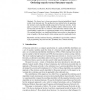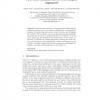2723 search results - page 28 / 545 » Learning lexicographic orders |
NECO
2010
13 years 5 months ago
2010
To allow the hidden units of a restricted Boltzmann machine to model the transformation between two successive images, Memisevic and Hinton (2007) introduced three-way multiplicat...
ECML
2007
Springer
14 years 1 months ago
2007
Springer
We discuss how to learn non-recursive directed probabilistic logical models from relational data. This problem has been tackled before by upgrading the structure-search algorithm i...
AAAI
1994
13 years 8 months ago
1994
We describe a method for learning formulas in firstorder logic using a brute-force, smallest-first search. The method is exceedingly simple. It generates all irreducible well-form...
ILP
2004
Springer
14 years 23 days ago
2004
Springer
Random forest induction is a bagging method that randomly samples the feature set at each node in a decision tree. In propositional learning, the method has been shown to work well...
AAAI
2011
12 years 7 months ago
2011
Coarse-to-fine approaches use sequences of increasingly fine approximations to control the complexity of inference and learning. These techniques are often used in NLP and visio...


